



Murray Farmhouse and Barn
345 Oak Hill Rd. / In Poricy Park
Map / Directions to Murray Farmhouse
Map / Directions to all Middletown NJ Revolutionary War Sites
For more information, see the Poricy Park Conservancy Website
The Murray Farmhouse and Barn are located within Poricy Park. Built circa 1770, it was the home of Joseph Murray, a stonemason who immigrated to New Jersey from Ulster County, Ireland in 1767 with his mother. He married Rebecca Morris, and the couple had four children, three sons and a daughter.
Joseph Murray was strongly pro-Independence, and he began serving in the Monmouth County militia in 1776. The Murray farmhouse was raided by Tories in 1779, and Joseph was sent to prison. (Tories were Americans who remained loyal to the British in the Revolutionary War.) Upon his release in January 1780, he resumed his militia service. His militia was ordered to commandeer horses, and Murray is believed to have taken one from Marlpit Hall, the home of Edward Taylor, a devout Tory. Marlpit Hall is located about three miles from the Murray Farmhouse, and is the subject of the next entry below on this page.
Several months later, on June 8, Joseph was working on his farm when he was shot in the back and then bayoneted by three men. It is believed that these men worked for Edward Taylor, and that they shot Joseph Murray in retaliation for stealing the horse. [1]
There is a small monument in the field where Joseph is believed to have been killed. Its plaque reads, "On June 8, 1780 at this site, Joseph Murray was murdered by Tories in retaliation for his daring patriot deeds."
Joseph Murray is buried in the cemetery of Middletown's Old First Church. (See entry lower on this page.)

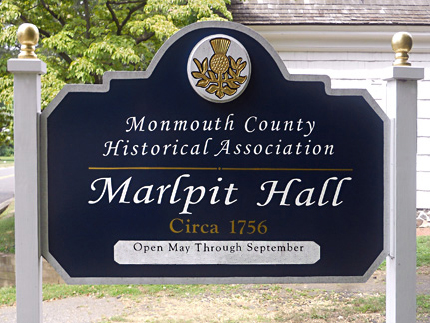

Marlpit Hall
137 Kings Highway
Map / Directions to Marlpit Hall
Map / Directions to all Middletown NJ Revolutionary War Sites
For current hours and admission information, see the Monmouth County Historical Association website
Marlpit Hall was the home of Edward Taylor. Prior to the war, Taylor was a prominent citizen of Monmouth County who was active and successful in local politics. He represented Monmouth County as a delegate in the New Jersey Assembly. [2]
In the years just prior to the war, Taylor was active in political resistance to British policies. In April 1774, he chaired Monmouth County's first county-wide meeting to resist British policies. On July 19, 1774, he chaired another important meeting. This time the meeting's purpose was to establish a county committee of correspondence. While the committee issued a document in protest of British policies, it was careful to do so in a way that was ultimately respectful of the British Crown. Rather than being an argument for independence from Britain, it argued for the colonists to be treated as if they had the full rights of British citizens while remaining within the British Empire. This is clearly illustrated in the wording of the following paragraph from within the document:
"[We] do highly esteem and prize the happiness of being governed, and having their liberty and property secured to them, by so excellent a system of laws as that of Great Britain, the best doubtless in the universe; and they will at all times cheerfully obey and render every degree of assistance in their power to the full and just execution of them. But at the same time will with the greatest alacrity and resolution, oppose any unwarrantable innovation in them, or any addition to or alterations in the grand system which may appear unconstitutional, and consequently, inconsistent with the liberties and privileges of the descendants of free born American Britons. [3]
Taylor remained politically active and continued to serve in the New Jersey Assembly, walking the line of protesting British policies while remaining loyal to the crown. As colonial protests began to turn increasingly radical and revolutionary, with calls for American Independence, Taylor chose ultimately to remain loyal to Britain. When the New Jersey Provincial Congress voted on June 17, 1776 to arrest the royal governor William Franklin, Taylor opposed this revolutionary act. Ten days later, Taylor was one of twenty-six citizens whose arrest was ordered by the New Jersey Provincial Congress because their American patriotism was in question. [4] Over the next several years, he was arrested several more times, and was put under house arrest in Marlpit Hall.
For the rest of the war, he continued to live in Marlpit Hall, but his Tory sympathies had cost him the prestige and prominence he once held in the community. At one point, a vigilante group threatened to burn down his house. Edward Taylor died January 18, 1783, nine months before the Treaty of Paris officially ended the Revolutionary War. He is buried, along with his wife Mary and son Colonel George Taylor, at the Throckmorton-Lippit-Taylor Burying Ground (See next entry below).



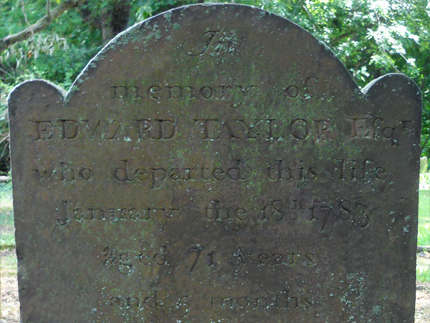

Throckmorton-Lippit-Taylor Burying Ground
Penelope Ln.
Map / Directions to the Throckmorton-Lippit-Taylor Burying Ground
Map / Directions to all Middletown NJ Revolutionary War Sites
Amongst the old gravestones of the Throckmorton-Lippit-Taylor Burying Ground (circa 1684) are those of Edward Taylor (See Marlpit Hall entry above) and his son Colonel George Taylor, who served in the local militia before choosing to serve with the British army. This is also the resting place of some of the earliest settlers of Middletown. [5] Posted on a board at the entrance is a lengthy description of the people buried here. The full text from the board, including a listing of all graves by rows, can be read here.
Middletown resident Brian Bugbee earned his Eagle Scout medal for restoration of this burying ground. His year-long project of research and restoration began in November 2001, and he received his Eagle medal in 2003. [6] Click here to read a 2003 newspaper story about Brian's project.

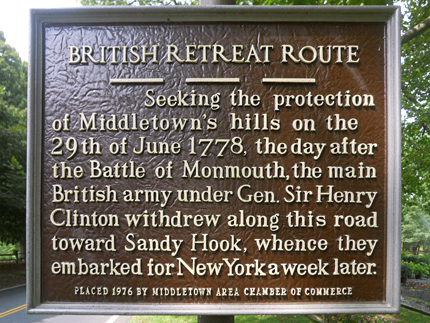
British Retreat Route Markers
• Church Street near Kings Highway
• Kings Highway near Normandy Rd.
• Kings Highway and Brandywine Way
Map / Directions to British Retreat and Campsite Markers
Map / Directions to all Middletown NJ Revolutionary War Sites
After the Battle of Monmouth, British troops under General Henry Clinton retreated toward Sandy Hook, from where they were transported by ships to British-occupied New York City on July 5, 1778.
This series of signs marks the retreat route of the British through Middletown on June 29, 1778, the day after the Battle of Monmouth. It begins on Church Street and then heads east on Kings Highway.
Following these signs will lead you to the area which is marked with two different sets of British Campsite signs.

British Campsite Markers (Kings Hwy/Monmouth Ave/Navesink Ave Series)
• Kings Hwy. near Chapel Hill Rd.
• Monmouth Ave. near Portland Rd.
• Monmouth Ave. near Locust Point Rd.
• Navesink Ave. and Woodhaven Ln.
• Navesink Ave. near Pape Dr.
Map / Directions to British Retreat and Campsite Markers
Map / Directions to all Middletown NJ Revolutionary War Sites
If you follow along the British Retreat Route markers, you will come to a set of signs along Kings Highway, Monmouth Avenue and Navesink Avenue which mark where British troops camped along both sides of the road.
They camped here from June 29-July 5, 1778, while waiting for ships to take them from Sandy Hook to New York City.

British Campsite Markers (Chapel Hill Road Series)
• Chapel Hill Rd. near Comanche Dr.
• Chapel Hill Rd. near Independence Rd.
Map / Directions to British Retreat and Campsite Markers
Map / Directions to all Middletown NJ Revolutionary War Sites
A different set of British Campsite signs runs on Chapel Hill Road, noting that "along this road and on hills to the east British soldiers erected and camped for a week after the Battle of Monmouth."
As noted above, the encampment lasted from June 29-July 5, 1778, while the British troops waited for ships to take them from Sandy Hook to New York City.


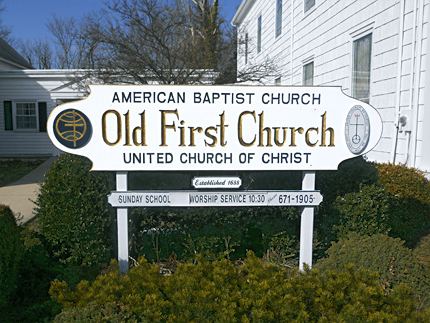
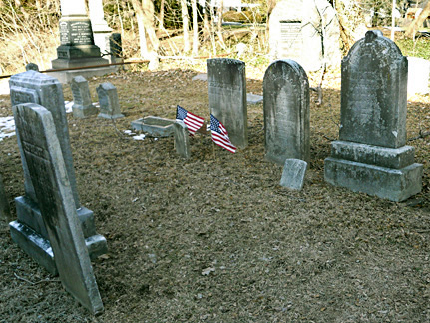

Old First Church and Cemetery
69 Kings Highway
Map / Directions to the Old First Church
Map / Directions to all Middletown NJ Revolutionary War Sites
The current church building (1832) is actually the third to stand at this spot since the church was established in 1688. According to the church's historian Elaine Lent, "Earliest historical references to the present church site give vague mention of a significantly earlier 17th Century building which may have originally served as the first Middletown Village meeting house and also as a place of worship. A piece of structural wood from the lowest level of the church has been radiocarbon dated to circa 1635, predating by 53 years the formal organization of the Middletown Baptist Church in 1688. A number of artifacts from the late 1600's have been unearthed beneath the present church sanctuary. The earliest wooden building was destroyed by fire sometime in the early 1700's. The second wooden church structure on the site (circa. 1735-1832) was standing at the time of the American Revolution. Following the destruction of the second wooden church by fire, the present church we see today was constructed in 1832. At 325 years of age, Old First Church represents the oldest, continuous Baptist congregation in New Jersey."
During the time of the Revolution, the Reverend Abel Morgan of this church was a strong supporter of the American cause, although members of the congregation included both Patriots and Tories. After the June 28, 1778 Battle of Monmouth, when British troops under General Henry Clinton retreated through and encamped in Middletown, they took over the church building, using it either as a barracks or hospital. Reverend Morgan wrote in his sermon notes that he had to preach "at Middletown, in mine own barn, because the enemy had took out all the seats in the meeting-house in town." Two British musket balls and part of a man's leather boot were found during recent excavations, possibly left by British soldiers who occupied the church following the Battle of Monmouth.
Reverend Morgan is buried in the cemetery. Joseph Murray, of the Murray Farmhouse, (see entry above on this page) is also buried here. Both Morgan and Murray were originally buried at the nearby Historic Presbyterian Cemetery (See next entry), and were reinterred here in the late 1800's. [7]
Several Revolutionary War soldiers are also buried here: [8]
Matthias W. Covenhoven (1762-1842)
Private, First Regiment, Monmouth County MilitiaJohn Stillwell (1737 or 1738 -1813)
Quartermaster, 1st Reg, Monmouth County Militia
John Stillwell's grave is located on the side of the church. There is a Revolutionary Soldier marker from the Monmouth Chapter of the D.A.R. at his gravesite, but no stone with his name. Alongside there is a D.A.R. Wife Of A Revolutionary Soldier marker for his wife that also has no gravestone.Obadiah Stillwell
July 21, 1744 -April 13, 1777
Corporal, First Regiment, New Jersey Militia
Captured at a skirmish in Navesink, believed to have died in British captivity


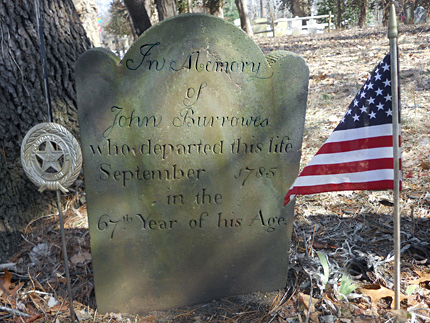
Historic Presbyterian Cemetery
Kings Highway and Kings Ct.
Map / Directions to Historic Presbyterian Cemetery
Map / Directions to all Middletown NJ Revolutionary War Sites
This cemetery contains the graves of three Revolutionary War veterans: [9]
Edward Burrowes
(1721 - Aug. 31, 1785)
John Burrowes
(Died Sept. 1785 - "in the 67th year of his age")
Major in Spencer's 5th New Jersey Regiment
Samuel Hopping
(Died Feb. 18, 1824 - "in the 81st year of his age")
Private, Morris County Militia

1. ^Anastasia M. Millicker, "Inside the Murray Farmhouse," Middletown Patch, August 12, 2012
▸ This article is based on an interview by Millicker with Melissa Jackson, the curator of the Murray Farmhouse.2. ^ The main source used for the information in this entry about Edward Taylor was:
Michael S. Adelberg, The American Revolution in Monmouth County - The Theatre of Spoil and Destruction (Charleston; The History Press, 2010) p.43-67
▸ In the chapter, "I Am Innocent as an Unborn Child" Adelberg provides a detailed and highly readable account of the Revolutionary War experience of Edward Taylor, as well as his son George.
Those interested in more detail about Edward Taylor are recommended to Adelberg's book.
▸▸ Adelberg does not list his sources in his book. However, he has published them in a separate document, The American Revolution in Monmouth County: Notes to Accompany the Book and Additional Essay, which he prepared for the Monmouth County Historical Association November 2010.
Available to be read here
The notes for the "I Am Innocent as an Unborn Child" chapter appear on pages 22 -29 of the PDF• For Taylor serving in the New Jersey Assembly and the New Jersey Provincial Congress, see:
Minutes of the Provincial Congress and the Council of Safety of the State of New Jersey (Trenton: Naar, Day & Naar, 1879) pages 63, 117, 169, 197, 199, 282, 325 and 445
Available to be read at Google Books here3. ^ William Nelson, Editor, Archives of the State of New Jersey, First Series, Volume XXIX (Documents Relating to the Colonial History of the State of New Jersey / Tenth Volume of Extracts from American Newspapers Relating to New Jersey 1773-1774) (Paterson NJ, The Call Printing and Publishing Company, 1917) p.458-459
Available to be read at Google Books here4. ^ Minutes of the Provincial Congress and the Council of Safety of the State of New Jersey (Trenton: Naar, Day & Naar, 1879) page 478
Available to be read at Google Books here5. ^ Information on the board at the entrance to the Throckmorton-Lippit-Taylor Burying Ground, written by Suzanne Bugbee for Brian Bugbee's Boy Scout Eagle Project, June 2003. The text on the board can also be read at the Middletown NJ website here
6. ^ Sandi Carpello, "Cemetery Project Earns Scout Rank of Eagle," The Hub, November 7, 2003
7. ^ The quote from Old First Church historian Elaine Lent, and much of the information in this entry, was obtained in telephone and email interviews with I conducted with Elaine on March 17, 20 and 21, 2014. Elaine provided the information about the timeline of church buildings, the Patriot/Tory makeup of the Revolutionary era congregation, the 1990's archeological dig, and the reinterment of Morgan and Murray.
I would like to thank Elaine for generously taking the time to speak with me about the history of the church.• The "at Middletown, in mine own barn, because the enemy had took out all the seats in the meeting-house in town" quote from Morgan's sermon notes appeared in:
E.J. Foote, A Sketch of the Life of Rev. Abel Morgan (1883) page 378. ^ Names, dates, and military information obtained with the help of the Old First Church historian Elaine Lent, based on gravestone information and church records. The identification of John Stillwell as the soldier buried at the spot of the unnamed D.A.R. marker was made by Elaine based on the church's cemetery map.
• Information about John Stillwell from the D.A.R. Genealogical Research System, where Stillwell is Ancestor # A1100869. ^ Name, date, and military information was drawn from gravestones in the cemetery, and information posted on the board at the entrance to the cemetery.